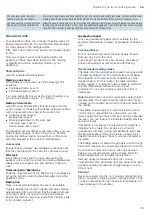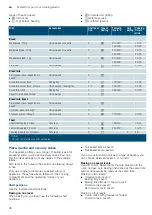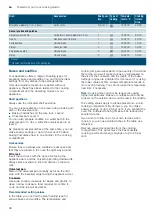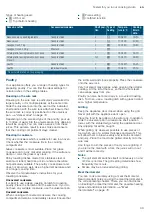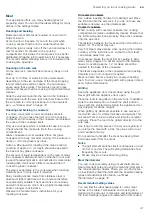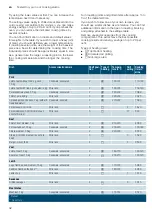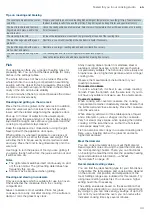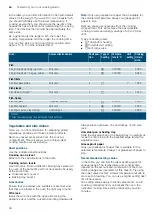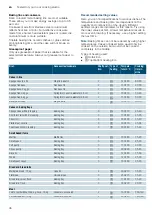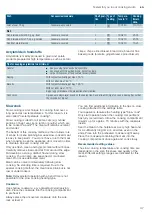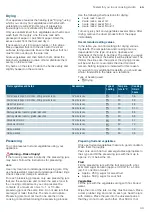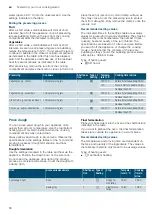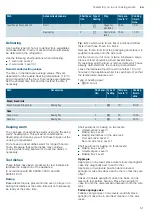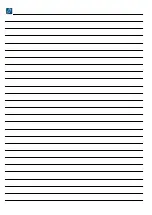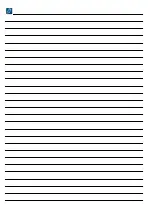
Tested for you in our cooking studio
en
49
Drying
Your appliance features the heating type "Drying", using
which you can dry fruit, vegetables and herbs with
outstanding results. With this type of preserving,
flavourings are concentrated by the dehydration.
Only use unblemished fruit, vegetables and herbs and
wash them thoroughly. Line the wire rack with
greaseproof paper or parchment paper. Drain the
excess water from the fruit and dry it.
If necessary, cut it into equal chunks or thin slices.
Place unpeeled fruit onto the dish with the sliced
surfaces facing upwards. Ensure that neither fruit nor
mushrooms overlap on the wire rack.
Grate vegetables and then blanch them. Allow the
blanched vegetables to drain off and distribute them
evenly on the wire rack.
Dry herbs on the stem. Position the herbs evenly and
slightly heaped on the wire rack.
Use the following shelf positions for drying:
■
1 wire rack: Level 3
■
2 wire racks: Level 3+1
■
3 wire racks: Level 5+3+1
■
4 wire racks: Level 5+3+2+1
Turn very juicy fruit and vegetables several times. After
drying, remove the dried products from the paper
immediately.
Recommended setting values
In the table, you can find settings for drying various
foodstuffs. The temperature and cooking time are
dependent on the type, moisture, ripeness and
thickness of the food to be dried. The longer you leave
the food to be dried, the better it will be preserved. The
thinner the slices are, the quicker the drying process
will be and the more aromatic the dried food will
remain. Setting ranges are indicated for this reason.
If you wish to dry additional foodstuffs, you should use
similar foodstuffs in the table as a reference.
Type of heating used:
■
'
Drying
Preserving
You can preserve fruit and vegetables using your
appliance.
:
Warning – Risk of injury!
If the food is preserved incorrectly, the preserving jars
may burst. Follow the instructions for preserving.
Jars
Use only clean and undamaged preserving jars. Only
use heat-resistant, clean and undamaged rubber rings.
Check clips and clamps in advance.
For each preserving process, only use preserving jars
that are the same size and contain the same food. In
the cooking compartment, you can preserve the
contents of a maximum of six
^
, 1 or 1
^
-litre
preserving jars at the same time. Do not use jars that
are larger or taller than this. The lids could rupture.
Preserving jars must not touch one another in the
cooking compartment during the preserving process.
Preparing fruit and vegetables
Only use fruit and vegetables that are in good condition.
Wash them thoroughly.
Peel, core and chop fruit and vegetables appropriate to
their type and fill the preserving jars with them up to
approx. 2 cm below the rim.
Fruit
Fill the preserving jars with the fruit along with a hot,
skimmed sugar solution (approx. 400 ml for a 1-litre
jar). For one litre of water:
■
Approx. 250 g sugar for sweet fruit
■
Approx. 500 g sugar for sour fruit
Vegetables
Fill the jars with the vegetables along with hot, boiled
water.
Wipe the rims of the jars, as they must be clean. Place
a damp rubber ring and a lid on each jar. Seal the jars
with clamps. Place the jars into the universal pan so
that they do not touch each other. Pour 500 ml hot
Fruit, vegetables and herbs
Accessories
Type of
heating
Tempera-
ture in °C
Cooking
time in
hours
Pomes (apple rings, 3 mm thick, 200 g per wire rack)
1-2 wire racks
'
80
3-6
Pomes (apple rings, 3 mm thick, 200 g per wire rack)
3-4 wire racks
'
80
6-8
Stone fruit (plums)
1-2 wire racks
'
80
4-8
Stone fruit (plums)
3-4 wire racks
'
80
8-10
Root vegetables (carrots), grated, blanched
1-2 wire racks
'
80
6-8
Root vegetables (carrots), grated, blanched
3-4 wire racks
'
80
6-8
Sliced mushrooms
1-2 wire racks
'
60
4-7
Sliced mushrooms
3-4 wire racks
'
60
7-9
Herbs, washed
1-2 wire racks
'
60
1-3
Herbs, washed
3-4 wire racks
'
60
3-6

